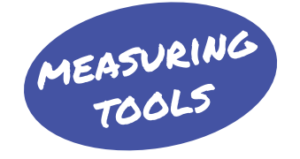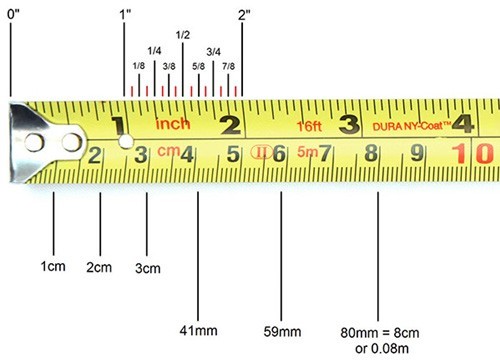1 Reading a Measuring Tape


- Imperial units: The longest marks indicate inches. Use the next longest lines for ½ inches, the third longest for ¼ inches, and so on.
- Metric units. The longest marks indicate centimetres. Use the smaller marks to find the length in millimeters.
- Stretch your measuring tape across the object. Find the nearest full measurement and add the length from the smaller markings.

How to read the measuring tape
Imperial
12 inches is the same as 1 foot. The number indicating feet on the tape may be a different colour or be labeled with an “F” to mark the length. After each foot marking, the numbers next to each inch mark will either repeat from 1-11 again or keep counting to 13, 14, 15, and so on. Each tape measure varies so be sure to check yours.
Recognize the third longest line as ¼-inch increments. Find the ¼-inch marks centered between the ½-inch and full-inch lines.
Check the fourth longest lines to find -inch increments. Look for the shorter-inch markings centered between each of the ¼-inch lines.
Measure sixteenths of an inch with the smallest, densely-packed lines. If there are lines that are even shorter than the -inch markings, then each of them represents
Reference to double arrows and diamonds for stud and truss spacing. 16 inches is the standard for wall studs. This will be marked with a set of 2 arrows. 19.2 inches is the standard for roof truss installation. This will be marked with a black diamond. If you’re not measuring for wall studs or roofing, don’t worry about any of these markings since you won’t need to use them.
Metric
Millimeters can be hard to read as they are the smallest, most densely-packed markings. Each millimeter represents
How to use the measuring tape
Place the tape’s hook at the end of the object you’re measuring. Hook the metal piece at the end of the measuring tape onto the edge of the object so it doesn’t slip. If you’re measuring the inside distance, such as the distance across a door frame or from one wall to another, push the metal hook flat against the surface instead. If the end of the tape measure has a hole, hook it onto a screw or nail to keep the end from moving.
Try to keep the tape as straight as possible since letting it sag can skew the measurement.
Use the lock switch to keep the tape at the same length. If you need to compare or transfer your measurement, slide the lock switch forward to keep the tape from retracting.


